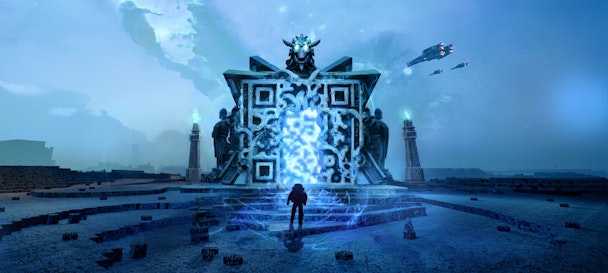This EE gaming campaign was made in matter of weeks – and supercharged by Unreal Engine
Saatchi & Saatchi and digital agency Collective explain how Epic Games’ real-time 3D creation tool is proving invaluable.

Key assets for Saatchi & Saatchi’s recent EE campaign were made by Collective, using Unreal / Collective
Physics engine Unreal has been used for years by game developers to create entire worlds. It’s the platform underlying titles such as Borderlands and Fortnite. It’s also an increasingly valuable part of the creative production toolkit.
London agency Collective has begun to specialize in the use of the software to create creative assets for the ad industry. Interest in the method and what it can potentially achieve is still nascent, however.
On one recent project, a Saatchi & Saatchi campaign for telco EE, Collective used Unreal to produce a large collection of video and still assets in just a matter of weeks. The work came together far faster than would have been possible using ordinary CG production methods.
Advertisement
Rachel Solomon, executive creative director at Saatchi & Saatchi, tells The Drum: “We initially explored creating this work in a more traditional CGI approach but found challenges financially, within our timings and also creatively.”
Pressed for time and faced with an intimidating brief to create still images showing four gaming-inspired ‘worlds’ for a campaign linking EE’s broadband services with multiplayer gaming, it went to production studio Collective.
“This was a slam dunk brief,” says Stephen Barnes, co-founder of Collective. “Unreal was the only way you could do this brief in the time we had. There was no other way of getting it done.”
Rather than design static renders of the ‘worlds,’ Collective’s team – including creative technologist Bora Demirbilek – used Unreal to produce each one as an interactive, 3D environment inside the engine. Using assets brought in from Unreal’s native marketplace and then edited, they built each environment up in a modular fashion – enabling the Saatchi team to request minor edits with relative ease.
In one of the scenes – a racing track clearly inspired by Mario Kart – the team added a simple traffic simulator to get racers moving correctly. “If you were to do this again, in a linear workflow, I don’t know how long it would take,” says Demirbilek. “I don’t even want to think about it.“
Advertisement
The pace of production possible by using the tech took creatives at Saatchi and its sister agency Digitas aback, with creative director Björn Conradi explaining: “At one point we joined a live session to review a version of the floating island. It looked absolutely fantastic, but the color palette was too close to some of the other executions and had to change drastically. This is obviously a ton of work when you have just built an entire world.
“I tried my best to deliver the feedback as delicately as possible, but before I was able to finish my sentence they changed some parameters on the time of day and position of the sun and it was done immediately. Working in Unreal is not so much 3D design as it is being a god in a world of your own making.”
In four weeks, the team produced each of the four worlds and was able to create video assets rather than just static renders with motion drift.
“We built a camera path through each scene, just to show off really,” says Barnes. “But that was a lightbulb moment for them. Once we build the scene you can have your static render, but we can do so much more. That’s when the juices started flowing.“
Suggested newsletters for you
Objects can be brought in via the platform’s asset marketplace and then edited, but creatives can also add their own rendered assets. For example, the QR-code gates shown in the still above were created using the generative AI tool Stable Diffusion, shares Demirbelik.
Unreal was also used to place typography into each spot rather than adding it over the top. The time clawed back on the project and the depth added to the gaming-themed activation allowed Saatchi to upgrade the work, originally intended only for social distribution, to include TVC and out-of-home.
“The TV ad and this were going to be very satellite, but they saw how it could become more integrated,” says Barnes. ”It really started to come to life.”
The latest edition of the software, Unreal Engine 5, bundles together several features that Collective’s team previously had to jury-rig. Meanwhile, universal scene description (USD) support within Unreal means that teams can use files and assets designed in Blender, for example, with full compatibility – widening the potential of the platform for creative means.
It still isn’t perfect, however. “There’s loads of stuff that is now native, but it still needs to be understood as a gaming engine, designed first and foremost for gamers,” says Barnes. ”We’re using it to suit our needs, but there are things it doesn’t do particularly well.”
Animating, for example, is less intuitive than in After Effects. Rendering objects that are supposed to be transparent in a scene – a window, say – can be difficult. “We’ve had to build our own systems for things like glass and transparencies. We’ve had to build our own shadow catcher to render shadows. Things like that can be a bit of a bummer.”
That aside, the largest snags are barriers to entry. Training a team in the use of Unreal for advertising creative is a significant investment of time while recruiting the right expertise is difficult.
“There’s a talent drain,” says Barnes. “All the really good engineers want to work in gaming because... well, why wouldn’t you? Apart from ours.“

